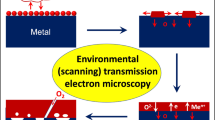Abstract
The depletion of an alloy by the selective removal of one element is considered when various rate laws apply. Duhamel's technique has been employed to obtain analytical solutions for the change in alloy composition with time. The effect of the depletion of the matrix by selective oxidation on the subsequent oxidation behavior of the alloy is discussed in terms of operating temperature of the alloy.
Similar content being viewed by others
Abbreviations
- C :
-
concentration of solute (g cm−3)
- C m :
-
bulk concentration of solute (g cm−3)
- C(x, t) :
-
concentration of solute at distancex from surface after timet(g cm−3)
- t :
-
time
- x :
-
distance
- ΔW o :
-
increase in weight due to takeup of oxygen
- ΔW m :
-
change in weight due to metal entering the oxide
- M o :
-
molecular weight of anion
- M m :
-
molecular weight of cation
- Z :
-
valency of cation
- θ :
-
2M m/M o
- k l :
-
linear rate constant (g cm−2 sec−1)
- k p andk′ p :
-
parabolic rate constants (g2 cm−4 sec−1)
- k e andk′ e :
-
logarithmic rate constants
- D :
-
diffusion coefficients of solute in metal
References
C. Wagner,J. Electrochem. Soc. 99, 369 (1952).
D. P. Whittle, D. J. Evans, D. B. Scully, and G. C. Wood,Acta Metall. 15, 1421 (1967).
D. P. Whittle, G. C. Wood, D. J. Evans, and D. B. Scully,Acta Metall. 15, 1747 (1967).
R. Hales. A. F. Smith, and J. C. Killeen, Proc. BNES Conf. on Corrosion of Steels in CO2 (Reading, 1974).
J. Crank,Mathematics of Diffusion (Oxford University Press, Oxford, 1967), p. 34.
H. L. Solbert, G. A. Hawkins, and A. A. Potter,Trans. ASME 64, 303 (1942).
S. J. Allan, J. F. Norton, and L. A. Popple, Proc. BNES Conf. on Corrosion of Steels in CO2 (Reading, 1974).
P. L. Surman, J. Bettelheim, R. B. Dooley, J. Graham, B. Meadowcroft, and P. C. Rowlands, Proc. BNES Conf. on Corrosion of Steels in CO2 (Reading, 1974).
A. W. Thorley and C. Tyzack, “Liquid Alkali Metals,” in Proc. Intern. Conf. at Nottingham University, p. 257.
J. W. Koger,Adv. Corros. Sci. Technol. 4, 245 (1974).
G. B. Gibbs and R. Hales, CEGB Report No. RD/B/N2706 (1973).
R. Hales and A. C. Hill,Corros. Sci. 12, 843 (1974).
W. S. Carslaw and J. C. Jaeger,Conduction of Heat in Solids (Oxford University Press, Oxford, 1962), pp. 75–77.
S. Dushman,Scientific Foundations of Vacuum Technique (John Wiley and Sons, New York, 1962).
A. F. Smith, J. C. Killeen, and R. K. Wild, CEGB Report No. RD/B/N3098 (1974).
D. P. Whittle,Oxid. Met. 4, 171 (1972).
R. Hales and A, C. Hill, unpublished data.
Author information
Authors and Affiliations
Rights and permissions
About this article
Cite this article
Hales, R. Compositional changes due to the removal of one constituent in an alloy by a surface reaction. Oxid Met 10, 29–40 (1976). https://doi.org/10.1007/BF00611697
Received:
Revised:
Issue Date:
DOI: https://doi.org/10.1007/BF00611697




